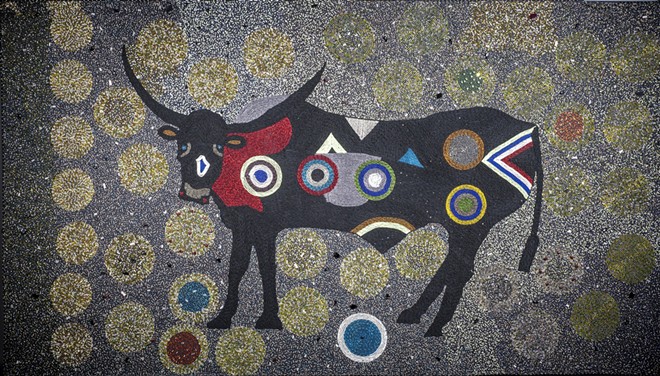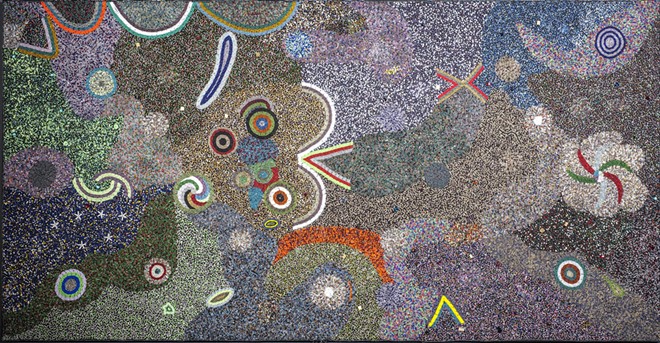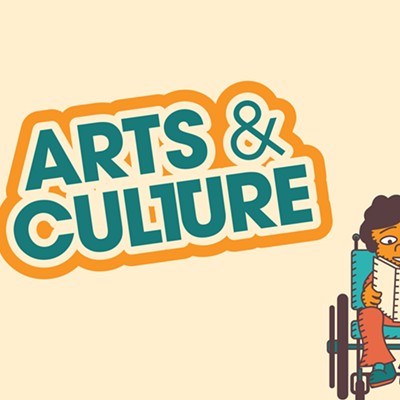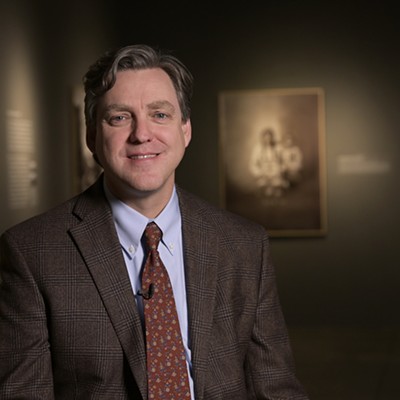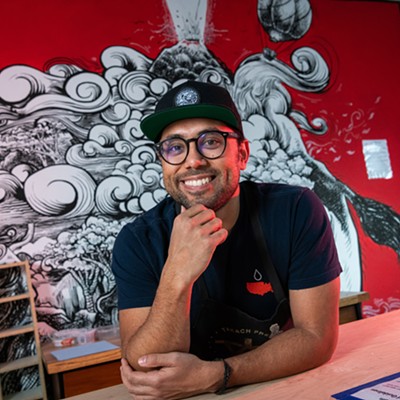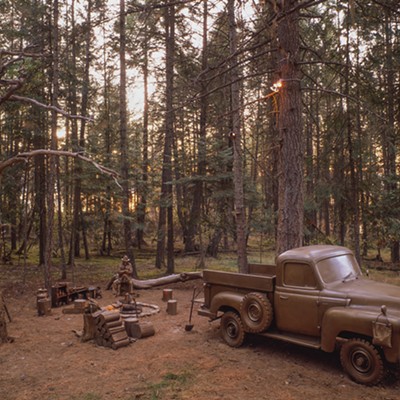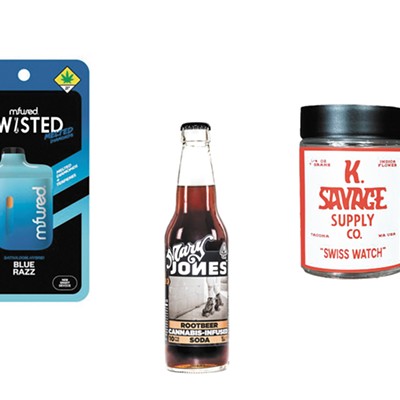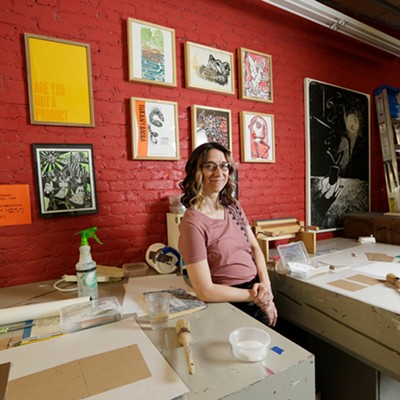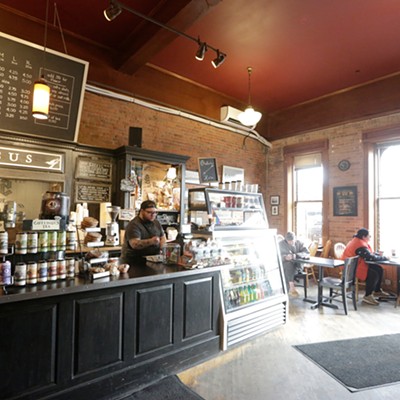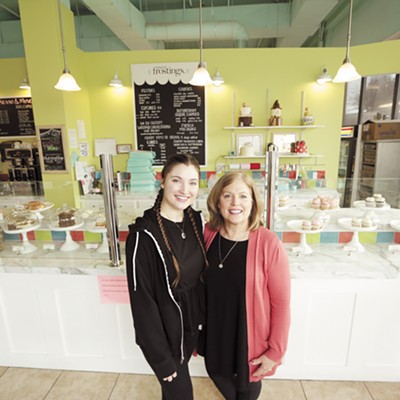Glittering light reflects off translucent glass beads of varying textures and sizes that are carefully threaded onto a neutral canvas, creating a sense of movement. The almost microscopic space between each bead allows your eye to roam freely along the edge of each vibrant flower, tree and abstract form they create.
The Northwest Museum of Arts and Culture is showcasing two beadwork exhibitions, "Ubuhle Women: The Art of Independence" and "Plateau Pictorial Beadwork: The Fred L. Mitchell Collection," from now until April 30 and May 14, respectively.
The first collection features 30 ndwangos (nid-WONG-gos), a Xhosa word meaning cloth, created by women in the South African art collective Ubuhle (uh-BOO-clay), a word that means "beauty" in both the Xhosa and Zulu languages.
"This is really a way for them to have a creative outlet and to have friendship, but also a way for them to create some financial independence because they sell their work," says Kayla Tackett, the MAC's director of Exhibitions and Collections.
The ndwangos have very personal meanings to each woman who creates them; some memorialize family members, some create a realistic portrayal of the world around them and others are more abstract. Throughout the exhibition, viewers may notice a red ribbon in certain pieces. It memorializes those lost to HIV or AIDS, a disease that has deeply affected the collective, which has lost five artists to the disease, Tackett says.
As the collective is formed of Xhosa and Zulu women, cultural differences can also be seen in the styles and artistic choices in the beading. The artists from the Xhosa culture, says Tackett, often use more white, pink and blue in their art, while those from the Zulu culture often use brighter colors such as red and orange. The Xhosa people are the second-largest ethnic group of Southern Africa, behind the Zulus.
"But of course, it's a living art, and the women influence each other, so it's really a melding of styles," Tackett adds.
Each beaded panel is created by an individual member of the collective, but collaboration is a key component of their art. This teamwork is showcased in a massive African crucifixion piece composed of over a dozen panels that stands at the heart of the exhibition.
"The way that they're kind of forging their own path together in a collective manner is pretty inspiring," she says.
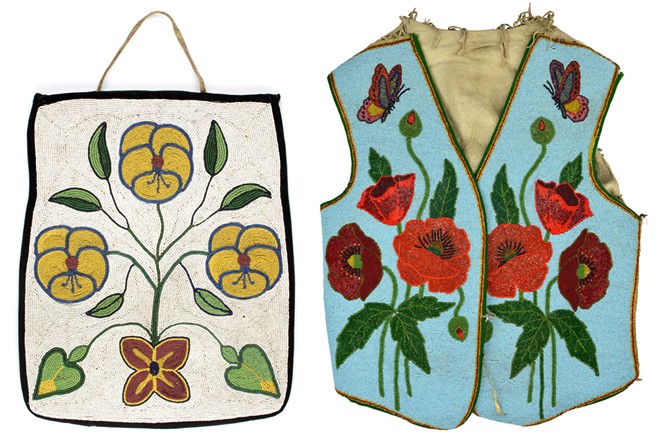
While the art in the "Ubuhle Women: The Art of Independence" exhibit was all created within the last 20 years, "Plateau Pictorial Beadwork: The Fred L. Mitchell Collection" showcases pictorial beadwork created by tribes of the Columbia River Plateau in the late 1800s and early 1900s.
The exhibit is a collaboration between Steven Grafe, a museum curator at the Maryhill Museum of Art in Goldendale, Washington, and Fred Mitchell, a lifelong collector of Native American artifacts and beadwork who lives in Walla Walla.
Mitchell has hundreds — possibly upwards of a thousand — such items in his collection, all of which are documented in Grafe's book Plateau Pictorial Beadwork: The Fred L. Mitchell Collection.
"I just want them to know about the Plateau peoples and their beadwork and enjoy the art," Mitchell says. "That's part of the reason for the book is that, no matter what happens down the line, every collection eventually gets split up. It's a way of documenting the collection long after it's no longer a collection. And that was my main intent, to show what these people have done, but also to preserve it as much as possible."
The Native peoples of the Columbia Plateau include the Nez Perce, Yakama, Umatilla and Warm Springs tribes. According to the MAC's American Indian collections curator Tisa Matheson, much of the research on tribal art in the Northwest has focused on Great Plains or Northwest Coastal tribes, so exhibits like this highlight the unique style and artwork specific to the Plateau tribes.
Mitchell mainly collects beadwork with horses, flowers, people and patriotic art, and while he does have a few newer pieces in his collection, he prefers older pieces and the knowledge that can be gained from them. He also attempts to find photographic documentation of the art he collects, as it preserves more history than the beadwork alone.
Unlike the Ubuhle beadwork, which is solely designed to be decorative, beadwork in the Plateau Pictorial exhibition is functional and designed for use in daily life and for special occasions, such as beaded bags and gauntlets. Along the back wall of the exhibit stand intricately beaded cradleboards for carrying babies and horse regalia used for celebrations and events.
Horse motifs are frequently depicted throughout the exhibition, which Matheson notes is significant in Plateau imagery as its tribes were one of the first to get horses back in the 1600s.
"A lot of the inspiration from these pieces are made for family members or for somebody who's special to them," says Matheson. "And so there's a lot of love that goes into the creation of these pieces, and the interpretation of the designs are up to the maker."
The beadwork in both exhibitions is a meticulous art; some pieces may only take a few months to finish while others can take a year or longer. And while beadwork takes just as much planning and creativity as traditional fine art mediums, says Matheson, it can still be overlooked as a craft rather than being labeled as an art due to the biases often present in academia.
"Instead of just hanging beautiful Native things in an exhibit, we really like to focus on a story behind why they're beautiful," she says. "A lot of academics have put Natives in a scientific category. And so we're trying to really put a human face back onto that."
Although the art styles and purposes of the objects in each exhibit differ, both collections are created with beads made in Europe, and showcase how similar materials were used and interpreted by different cultures in two different time periods.
"It is just serendipitous that we could do them both and have this really wonderful representation in two galleries at the same time," Tackett says.
The display of both collections highlights the MAC's broader goals, as well, Tackett says, to not only highlight art and history of the Inland Northwest, but to bring the world to Spokane.
The Ubuhle beadwork, which was developed by the Smithsonian Anacostia Community Museum in Washington, D.C., is touring museums throughout the country, and the Plateau Pictorial beadwork is on loan from Mitchell's private collection.
"I've heard from a lot of our guests here that they've been really blown away by how beautiful this work is, but also, they can appreciate how difficult it must be to produce," Tackett says.
"It's a really great way to learn about other people, other cultures, to see artwork that you may not otherwise see, to appreciate the way that people appreciate beauty all around the world." ♦
"Ubuhle Women: The Art of Independence" (through April 30) and "Plateau Pictorial Beadwork: The Fred L. Mitchell Collection" (through May 14) • Open Tue-Sun from 10 am-5 pm • $7-$12 • Northwest Museum of Arts & Culture • 2316 W. First Ave. • northwestmuseum.org • 509-456-3931

